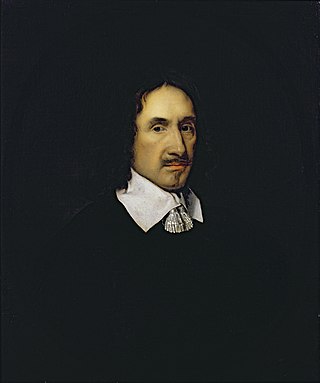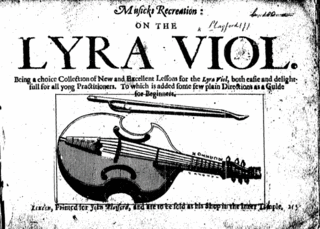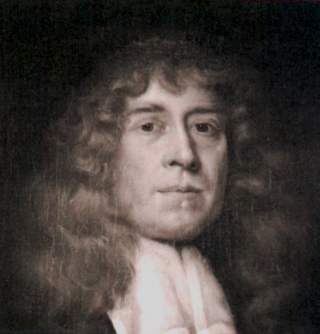Related Research Articles

The viola da gamba, or informally gamba, is any one of a family of bowed, fretted, and stringed instruments with hollow wooden bodies and pegboxes where the tension on the strings can be increased or decreased to adjust the pitch of each of the strings. Although treble, tenor and bass were most commonly used, viols came in different sizes, including pardessus, treble, alto, small tenor, tenor, bass and contrabass. Separating these from other bowed string instruments such as the viola da braccio was the instruments' orientation; members of the older viol family were played with the neck oriented upwards, the rounded bottom downwards to settle on the lap or between the knees.

Henry Lawes was the leading English songwriter of the mid-17th century. He was elder brother of fellow composer William Lawes.
John Jenkins (1592–1678), was an English composer who was born in Maidstone, Kent and who died at Kimberley, Norfolk.

John Playford (1623–1686) was a London bookseller, publisher, minor composer and member of the Stationers' Company. He published books on music theory, instruction books for several instruments and psalters with tunes for singing in churches. He is perhaps best known today for his publication of The English Dancing Master in 1651.

Tobias Hume was a Scottish composer, viol player and soldier.
John Coprario, also known as Giovanni Coprario or Coperario, was an English composer, viol player and teacher.

William Lawes was an English composer and musician.
Bowed string instruments are a subcategory of string instruments that are played by a bow rubbing the strings. The bow rubbing the string causes vibration which the instrument emits as sound.

Christopher Simpson (1602/1606–1669) was an English musician and composer, particularly associated with music for the viola da gamba.
Alfonso Ferrabosco the younger was an English composer and viol player of Italian descent. He straddles the line between the Renaissance and Baroque eras.

The lyra viol is a small bass viol, used primarily in England in the seventeenth century.

The division viol is an English type of bass viol, which was originally popular in the mid-17th century, but is currently experiencing a renaissance of its own due to the movement for historically informed performance. John Playford mentions the division viol in his A Brief Introduction of 1667, describing it as smaller than a consort bass viol, but larger than a lyra viol.
Charles John Grayston Ives, also known as Bill Ives, is a British composer, singer and choral director.
Martin Peerson was an English composer, organist and virginalist. Despite Roman Catholic leanings at a time when it was illegal not to subscribe to Church of England beliefs and practices, he was highly esteemed for his musical abilities and held posts at St Paul's Cathedral and, it is believed, Westminster Abbey. His output included both sacred and secular music in forms such as consort music, keyboard pieces, madrigals and motets.
John Webb is an English composer.
Thomas Brewer was a 17th-century composer best known for introducing the glee form. Little is known of his life. However many of his compositions have survived. Most of them are catches, rounds and glees but three instrumental pieces are stored in the Oxford Music School collection.
Daniel Farrant (1575–1651) was an English composer, viol player and instrument maker. He invented types of citterns, the poliphant and the stump, along with the early lyra viol. He is also credited with the invention of the early viola d'amore. The particulars of the stump are not known.

Jonathan Dunford is an American violist specialising in the baroque repertoire.
William Drew was an English composer. Few of his compositions are known, all for viola da gamba solo, in lyra-viol style, or for a consort of viols. One of the many lyra-viol tunings takes its name from him. This suggests that he was a lyra-violist.

George Hudson was an English violinist, lutenist, singer, and composer of Baroque music.